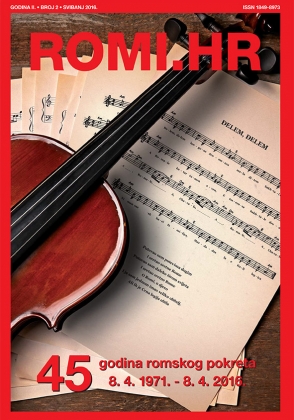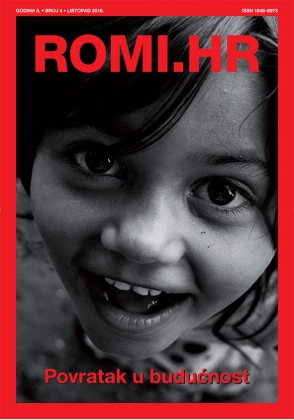Zanimljivosti ROMI.HR
/Prijevod: Antonia Mudrovčić
Grad Soroca u Moldaviji nalazi se na desnoj obali rijeke Dnjestar na granici s Ukrajinom. Jedna od glavnih atrakcija grada je "Romsko brdo" - četvrt gusto naseljena Romima, koju karakterizira neobična arhitektura zgrada. Posljednjih godina ovo područje privlači pažnju brojnih turista koji dolaze vidjeti ogromno područje naseljeno Romima.
Grad Soroca često se naziva romskom prijestolnicom Moldavije. U tom gradu postoji čak i romski barun, koji sebe naziva romskim barunom čitave Moldavije. Ovdje ima na stotine luksuznih kuća koje su nekada gradili Romi. Međutim, ljudi ovdje nisu gusto naseljeni. U svakoj ulici postoje prazne kuće koje nisu dovršene, i nisu nastanjene.
Što se onda dogodilo s gradom da izgleda tako pusto, što je otjeralo većinu romske populacije? Raspad SSSR-a utjecao je na dobrobit Roma u gradu Soroci, pa su se počeli iseljavati u Europu. Dio je ipak pokušao ostati u domovini, ali onda je kriza 2008. godine otjerala većinu preostalih Roma. Prema riječima Roma koji žive u Soroci, najpopularnije zanimanje bilo je, i dalje ostaje trgovina.
Grad Soroca nije se oduvijek smatrao romskim naseljem. Početkom 20. stoljeća Soroca je bila židovski grad, a u njemu je živjelo samo 12 Roma. Današnji podaci pokazuju da Romi ne čine više od 3% stanovništva. Većinu populacije čine Moldavci, Ukrajinci i Rusi.
Ako većina stanovništva u gradu nisu Romi, zašto se grad smatra romskom prijestolnicom? Zbog toga što već na prvi pogled prilikom posjeta gradu, čovjek bi bio fasciniran luksuznim kućama koje su Romi izgradili za sebe tijekom 80-ih i 90-ih godina. To znači da su ove luksuzne kuće izgrađene u SSSR-u i isticale su se u odnosu na jednostavnost koja je karakterizirala SSSR.
Arhitektura je uistinu izvanredna. Tamo se mogu pronaći kuće koje su nalik američkoj Bijeloj kući ili Boljšoj teatru u Moskvi. Neke kuće izgledaju kao srednjovjekovni dvorci, druge imaju antičke skulpture ili orijentalne motive. Generalni moto je – gradi bolje nego tvoj susjed, neka izgleda kao da si bogatiji od svog susjeda. Većina kuća ima 3-4 kata. Svako zemljište nije previše veliko, ali to nije spriječilo ljude u gradnji golemih kuća na cjelokupnoj površini zemljišta. Ponekad su prozori kuće udaljeni svega nekoliko centimetara od susjedove kuće. Imati veliku luksuznu kuću smatra se apsolutnom potrebom među Romima koji žive u Soroci.
Šećući gradom u današnje vrijeme naići ćete na mnoge napuštene kuće. Vlasnici su te kuće napustili i prije nego što su one u potpunosti izgrađene. Ulice nemaju ni ceste. Vrlo rijetko će se naći ulica s hrpom kuća koje su naseljene. Ljudi bi se tamo okupljali kako bi razgovarali na ulicama, sjedili vani na klupama, ponekad na pikniku uz piće sa susjedima. Na većini zemljišta je napušteni dvorac i vrlo mala kuća, ili čak šator, gdje obitelj zapravo živi.
Još jedna rijetkost u gradu Soroca je sresti mladog muškarca. Svi mladići putuju zbog posla (uglavnom trgovine) u Europu ili Rusiju. Prije 30-40 godina većina je Roma trgovala džersejem u SSSR-u, a i u novim državama koje su nastale nakon raspada SSSR-a. Ali nakon uspjeha kineskih i turskih trgovaca tkaninama, za Rome nije bilo mjesta na ovom tržištu. To je natjeralo Rome da napuste rodni kraj i potraže posao u drugim zemljama (uglavnom europskim). Oni koji su ostali u gradu dobivaju novac od povremenih poslova kao što su organiziranje vođenih tura za turiste ili davanje intervjua za društvene mreže ili portale s vijestima. Inače, priča se da mlađa populacija marljivo uči engleski kako bi mogla organizirati ture za turiste. Neki ljudi pozivaju turiste u svoju kuću, daju im topli obrok, i proriču im budućnost, a oni sve to plaćaju.
Većina Roma u Soroci su pravoslavne vjeroispovijesti, tako da se vraćaju svojim obiteljima u siječnju za Božić i u proljeće za Uskrs. U to vrijeme grad ponovno oživi. Ako član obitelji radi u Rusiji, onda je poželjno vratiti se s luksuznim automobilom (npr. Mercedesom, Lexusom, Range Roverom, itd.) s moskovskom registracijskom oznakom. Ako imate bilo koju drugu registracijsku oznaku - to znači da niste uspješni u očima romske populacije grada. Iako svaka kuća ima garažu, luksuzni automobil uvijek bi ostao vani da ga svi vide.
Hoće li grad Soroca u Moldaviji ikad više vratiti svoje bogatstvo? Zasigurno ne možemo predvidjeti budućnost. Ali čak i danas ljudi daju sve od sebe da si sagrade dvorac.
The city of Soroca in Moldova is located on the right bank of the Dniester River on the border with Ukraine. One of the main attractions of the city is the "Roma Hill" - a district densely populated by Roma, characterized by unusual architecture of buildings. In recent years, the area has attracted the attention of many tourists who come to see the huge area inhabited by settled Roma.
The city of Soroca is often called the Roma capital of Moldova. There is even a Roma baron here who calls himself the Roma baron of all Moldova. There are hundreds of luxurious houses here, once built by Roma. However, the population of people is not dense here. On every street there are ghost houses that were not completed and were not inhabited.
So what happened with the city that made it look ghostly, what drove the majority of the Roma population away? The collapse of the USSR affected Romas’ wellbeing in Soroca, so the population started to move away to Europe. Some people still tried to stay in their Homeland, but then the crisis of 2008 drove away most of the remaining Roma. As per words of Roma in Soroca the most popular occupation was and is trading.
The city of Soroca wasn’t always considered to be a Roma settlement - at the beginning of the 20th century, Soroca was a Jewish city, and there were only about 12 Roma. The census data nowadays shows that Roma make up no more than 3% of the city's residents. Most of the population are Moldovans, Ukrainians and Russians.
If the majority of the population in Soroca are not Roma, why is the city considered to be a Roma capital? Because at the very first glimpse while visiting the city, one would be fascinated by luxurious houses Roma build for themselves over 80-es and 90-es. This means that these luxurious houses were built in the USSR and were extremely outstanding, contrasting with the overall simple life of USSR.
The architecture is indeed outstanding. You can find a house looking like an American White House, like the Bolshoi Theater in Moscow. Some houses look like medieval castles, others have antique sculptures or Oriental motifs. The general motto is - build better than your neighbor, look richer than your neighbor. Most of the houses are 3-4 stories high. Overall, each land is not very big, but it didn’t stop people from building immense houses for whole areas of their land - sometimes windows of a house are just a couple of centimeters away from a neighbors house. To have a huge luxurious house is considered to be an absolute necessity among Roma living in Soroca.
Walking around the city nowadays you will find a number of ghost houses - they were left by their owners even before the house was properly built. The streets don’t even have roads. Very seldomly will there be a street with a bunch of living houses. People there would gather to chat on the streets, sitting on the benches outside, sometimes having a picnic with drinks with the neighbors. Most of the lands include a ghost castle and a very tiny house or even a tent, where a family actually lives.
Another rarity in the city of Soroca is to meet a young man. All the young men travel for work (mostly trading) to Europe or Russia. 30-40 years ago most of the Roma used to trade jersey fabrics in the USSR and then in former USSR countries. But after the success of Chinese and Turkish fabric traders, there was no place for Roma in this market. That made Roma people leave their homeland of Soroca and seek jobs in other countries (mostly European). Those who stay in the city get money from occasional jobs like giving tours for tourists or giving interviews to social media or news channels. By the way, it is said that the younger population is eagerly learning English to give tours to foreign tourists. Some people can invite tourists to their house, give them a warm meal and then tell you your fortune, which you have to pay for.
Most of the Roma in Soroca are Orthodox Christian, so they come back to their families in January for Christmas and in Spring for Easter. Those are the times when the city becomes lively again. If a family member works in Russia, then a good tone would be to come back with a luxury segment car (e.g.: Mercedes, Lexus, Range Rover, ets.) with Moscow registration number. If you have any other cities’ registration number - that means you are not successful in the eyes of the city’s Roma population. Even though every house has a garage, a luxury car would always stay outside to be seen by everybody.
Will the city of Soroca in Moldova ever embrace its wealth again? We certainly cannot predict the future. But even nowadays people are trying their best to build a castle for themselves.
 Povratak na zanimljivosti
Povratak na zanimljivosti

.jpeg)











